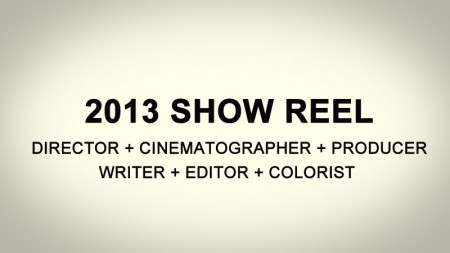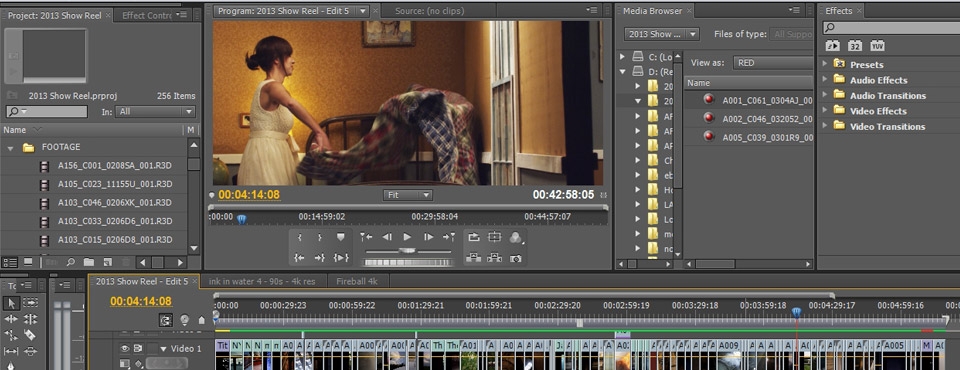There are a lot of demo reels out there. Some are very impressive – others are not so impressive. What can you do to make the best impression with someone that’s seeing your work for the first time? In this entry, we’re going to go over some of the variables and try to get you pointed in the right direction.
First, it’s probably good to address the fact that there is a type of reel for pretty much any position in the film industry – cinematography, directing, editing, vfx, lighting, acting, HMU, sfx, color grading, etc. Each type will have its “do’s and don’ts”. As a DP, I’m going to focus on cinematography reels…
Next, before rolling our sleeves up and jumping into cinematography reels, I want to take a moment to address the “I can do everything” demo reels. I’m sure you’ve seen them. In these reels, the person demonstrates that he or she can direct, edit, write, color grade, be a cinematographer, etc.

If this is the way you want to try to sell yourself in the film industry, I highly recommend doing one of the following things:
- Have a separate reel for each of the aspects of film making that you are doing. If you are directing – have a directors reel that shows your directing ability. If you also DP, have a separate cinematography reel as well. Do this is as many times as you need to.
Of the two options, I like this one the best. It allows you to most efficiently showcase your skills for the job you are specifically targeting. If you’re going after a directing job – send your director’s reel. If you’re going for a DP job, send them your DP reel. There’s no confusion about what is being seen or what role you played in the footage being shown.
- If you have one primary reel that mixes positions of film making, edit it in clearly defined sections that identify what skill you are showing the viewer. If you start your reel with directing, make sure the viewer knows it. Mark those sections well and make sure your audience knows what they’re looking at.I want to point out what’s going to happen if you don’t label your sections – prospective employers won’t know what they’re looking at. If you are selling yourself as a director, editor, dp, colorist, producer and writer but you don’t label what you did for what shot, your viewer will have absolutely no clue as to whether the clip they’re looking at was directed by you, edited by you, shot by you, etc. Unless you did every single position for every clip, make sure people know what role you did in what you’re showing them. It will be the best way to accurately represent yourself in this combo-style reel.The downside to having a categorically sectioned show reel is that if a prospective employer is looking for one specific aspect of film making to hire you for and that section is not the first section they see – then they either have to wait through something that doesn’t apply to why they’re considering you or they have to skip through the reel to find the content they’re trying to watch. Either way, you’re making their job harder to find the content they want to see.
I also want to take a minute to go over the two primary types of reels that I see out there. There is the cumulative reel which compounds footage from year to year – honing in and refining the best moments of your craft from whenever you choose to start it and now. Then there is the standalone reel which has exclusive footage to that reel and does not correspond with any years prior. There is no right or wrong with whichever reel type you choose. I personally prefer standalone reels for one specific reason – if I’ve seen someone’s demo reel from the year before and am excited to see their new footage and only see a few new clips and feel that most of the reel is a repeat of the previous one, I’m a little less interested in seeing the next reel. Granted, someone seeing that new reel for the first time won’t have that perspective – so again there is no wrong choice for that.
Now let’s move on to cinematography reels more specifically.
What is that is going to sell your skills? I like to look at it a very specific way… I ask myself, “What am I showing?” Often times I strive to demonstrate a minimum of one of the following qualities in any footage I would want to show in a reel:
camera movement, lighting, composition, visual creativity, versatility, or a great moment.
Usually it’s ideal to get more than one of these in the same shot but as long as you have one of them, you’re probably in pretty good shape.
Since camera movements, lighting, and composition are pretty self-explanatory, I’m going to jump ahead to versatility. Like many of us out there, variety is the spice of life. I don’t want to do the same thing every day. That’s why I don’t work a regular 9-5 job. This also applies to what I shoot. I think I’d get really bored if I had to shoot the same thing every day – so it’s a primary goal of mine to make sure I can show that I can shoot almost anything. How could I get hired to shoot almost anything if I only showed one or two types of footage in my reel. By emphasizing variety and versatility in my reel, it reinforces my cinematography skills overall and helps me maintain the variety in my shoots that I prefer. If you only want to shoot one or two types of things – then this isn’t really as important for your reel.
What do I mean by a great moment? This is just something that speaks to you as something that’s worth showing even thought it doesn’t necessarily fit into any of the other attribute categories. There might not be any camera movement at all; it might use all natural lighting that you had nothing to do with; the composition might be fine but nothing exceptional – but it just works. You know it when you have it. Here is a screengrab from one of my favorite shots that probably falls into this category.
Now let’s move on to some of the “don’t do” items. Keep in mind these are my personal views and you can do them if you want to…
- Live concert footage. I see this a lot and have never cared for it. I’ve shot a lot of live footage. I’ve shot documentaries. And with those shoots, I have shot some seriously beautiful stuff in those circumstances but to me, it’s all reactionary and doesn’t allow me to really showcase my craft or what I can do visually. The camera moves are often non-existent and the shots are more luck than being crafted… This is coming from a cinematography standpoint. If you’re a lighting designer and you are controlling all of the concert lights, that’s obviously a totally different story. For my purposes, unless it’s ultra high profile musical artist with major global recognition, I’m not putting it in my reel.
- Repetition. This is something else I see a lot. If you don’t have a lot of content, it might be better to have a shorter reel and really make a strong impression than to keep going back to footage you’ve already shown. It gives the impression that you ran out of good stuff to show and you’re trying to stretch things out.Now let me put a side note into this item – It’s totally okay to return to footage from a project as long as you’re showing something different. I’ve shot some killer projects that had tons of variety, camera movement and lighting design. In my upcoming 2013 show reel, I will absolutely be returning to a few projects to show different things – BUT, when I do, I won’t be showing the same thing as the other clips from that project. I will make sure that it’s different lighting, different camera moves, or content variety that’s really showcasing versatility. I consider this a very strong exception – it only feels repetitious if the viewer is not engaged. If it’s the same thing over and over again, that’s when it’s a really bad thing. One thing you can do to avoid the perception of repetition is to group all of your related shots from a scene or project together – that way it’s not scattered throughout the reel and giving the impression of nothing else to show. For example, if you have three or four shots from the same project that are all showing basically the same content with no real variation of camera movement, lighting, drastic difference in composition – if you have those same shots back to back in your reel – it’s more of a themed segment inside the reel rather than “oh, he didn’t have anything else to show”.
- Duration. Most people are very good about this but it should be noted since this blog post is pretty thorough. The average show reel is commonly about two minutes or less. This gives you time to show some of your best footage and leave the viewer wanting more. It should also be noted that many times a prospective employer will only watch the first 15 to 30 seconds of your reel before moving on to the next one. I’ll admit – I’m particularly bad at this aspect of creating show reels and my cinematography reels often clock in around 5 minutes… Luckily I’ve had good luck in the fact that many people watch the whole reel. I also don’t create a new show reel each year – so I’m often cramming two+ years of footage into each reel. I’ve considered having two versions – one that’s super short 90 seconds or so and then the full version. To date, I’ve only done the full version though.
- Put your best foot forward. When you’re editing your reel, keep in mind the point made in #3. If a prospective employer is only going to watch the first 15-30 seconds of your reel, put your best footage at the beginning. If nothing else, it will engage the viewer and encourage him/her to continue watching. If you put weaker stuff in the beginning, your audience might never make it to the middle or end (wherever you’re hiding the good stuff). Also, on this point – try to edit in such a way that you end strong. Obviously your reel is showcasing the best you have to offer but look at it this way – the beginning has to keep them watching and the ending is going to stick with them in their memory… so put something strong at the end to make sure it sticks with them.
- Green Screen. Green screening has never really done it for me. I put it more in the category of editing and vfx. Sure we need to have our lighting right so they can get a clean key – but it’s far less about amazing cinematography for the average show reel than it is about all of the effects they’re putting in after you’ve done your part. It would be pretty rare for me to include green screen footage in any of my reels.
- Contact Information. Make sure that people can reach you. They might not have your website, business card, e-mail address, phone number, or whatever… So make sure that if the only thing they have is your reel – they can still contact you.Again, I’ll admit being guilty of not following this one – however, I’ll give you a little story to go with it. At the time of releasing my 2011 show reel, I was in talks with a handful of production companies that were very excited about the footage and the reel. I omitted my contact information so that it could be utilized directly on various product company websites without usurping any initial contact from potential clients. Two years later, I will not be repeating that tactical decision for the upcoming 2013 reel.
Here’s the 2011 cinematography reel I did if you want to check it out:


